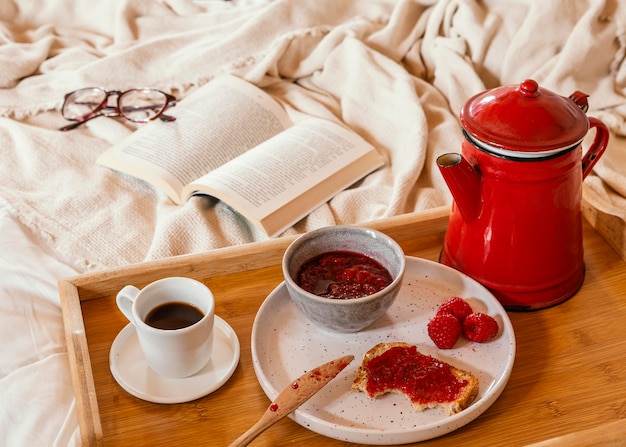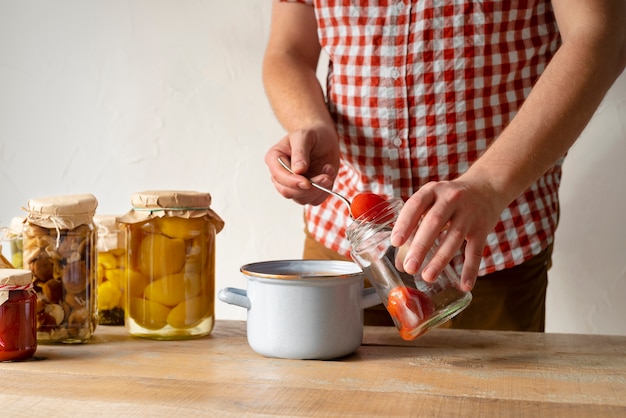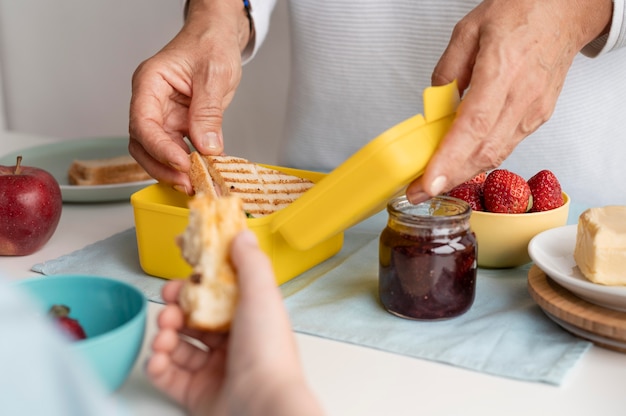(Part 1) The Essential Tools

Choosing the Right Equipment
Before you embark on this jam-making journey, you need to gather your tools. Think of them as your trusty companions, the ones that'll help you achieve jam-making greatness.First, a good, heavy-bottomed saucepan is a must. It's where all the magic happens, where fruit, sugar, and pectin come together to create a delicious symphony. You need something that can withstand the heat of simmering jam and won't warp or buckle under the pressure. Next, a jam thermometer is an absolute lifesaver. It’s the key to ensuring your jam reaches the perfect setting point, that sweet spot where it's thick enough to spread but not too firm. Beyond that, you'll need a few basic kitchen utensils: a trusty wooden spoon for stirring (the best for preventing sticking), a ladle for transferring your jam, and a set of clean jam jars with lids. Now, when it comes to jars, I'm a firm believer in preserving jars. They're wider at the top than the bottom, making it much easier to fill them up and reducing the risk of spills.Getting Your Supplies Ready
Now that you've got your trusty tools ready, let's talk about the ingredients. The main trio – your chosen fruit, sugar, and pectin (if you need it) – is what makes the magic happen. For the fruit, choose ripe and juicy varieties. You want those bursts of flavour and vibrant colours to shine through. And don’t be afraid to get creative! Experiment with different fruits and combinations – strawberries and raspberries, peaches and nectarines, blueberries and blackberries, even apples and pears. Sugar is the jam's best friend. It preserves the fruit, adds sweetness, and helps it set properly. You'll typically use a 1:1 ratio of fruit to sugar, but the exact amount can vary depending on the fruit you're using. For fruits that are naturally low in pectin, you might need to add a bit more sugar to help it thicken.Now, let's talk about pectin. It's a natural substance found in fruit that helps the jam set. Some fruits are naturally high in pectin (like strawberries and raspberries) and set perfectly without it. But for fruits that are low in pectin (peaches, apricots, etc.), you'll need to add some. You can buy pectin in powdered or liquid form, but I always go for powdered pectin because it's readily available and easy to use. Just be sure to follow the instructions carefully.
Prepare Your Fruit
Alright, now it's time to prep your fruit. This step is important for ensuring your jam has a smooth texture and a beautiful, even colour.Start by washing your fruit thoroughly and removing any stalks, leaves, or bits of debris. Then, depending on the type of fruit, you might need to chop or slice it. If you're using berries, you can keep them whole, but for larger fruits like apples, plums, or peaches, you'll want to remove the core and cut them into smaller pieces. I prefer to chop them into chunks about 1 cm in size. You can use a food processor, but I find it more satisfying to do it by hand.(Part 2) Mastering the Art of Jam Making

Choosing Your Fruit
Choosing the perfect fruit is like casting the lead role in your jam-making masterpiece. You want something ripe, bursting with flavour, and with a natural vibrancy that will shine through in your finished jam.Strawberries: The quintessential jam fruit, they offer a sweet and tangy flavour, and their vibrant red hue makes for a stunning jam.
Raspberries: These delicate berries lend a bright, sweet flavour and a gorgeous pink hue to your jam.
Blackberries: They provide a rich, dark colour and a slightly tart flavour, perfect for those who prefer a bolder taste.
Plums: A good choice for jam, especially when you're after a rich, complex flavour with a hint of tartness.
Apricots: With their delicate flavour and bright orange colour, they create a jam that's both visually appealing and incredibly delicious.
Adding Sugar
Sugar is a crucial ingredient in jam making. It not only adds sweetness but also acts as a preservative, preventing spoilage and helping the jam to set properly.Granulated sugar: It's the classic choice for jam making, readily available, and dissolves easily. It also doesn’t interfere with the colour of the jam.
Caster sugar: A finer grain than granulated sugar, it dissolves more quickly and creates a smoother texture.
Brown sugar: Adding a touch of brown sugar to your jam can add a hint of caramel and richness.
Understanding Pectin
Pectin is the unsung hero of jam making, the magic ingredient that helps your jam set and achieve that beautiful, gel-like consistency.Powdered pectin: It's a convenient and readily available option. It's typically mixed with a small amount of sugar before adding it to the jam.
Liquid pectin: It's a concentrated form of pectin that's often used in low-sugar jams.
Getting Your Jam Cooking
Now it’s time to put your culinary skills to the test and get your jam cooking. Combine your prepared fruit, sugar, and pectin (if you're using it) in your trusty saucepan. Place it on the stovetop over medium heat and bring the mixture to a boil, stirring frequently. This prevents sticking and helps the sugar dissolve. Once the mixture is boiling, continue cooking for about 10-15 minutes, or until it reaches the setting point. The jam thermometer will be your best friend here, letting you know when the magic is happening.
Adding Flavour and Colour
While your jam is bubbling away, you can have some fun and add your own personal touch of flavour. A splash of lemon juice is a classic addition to many jams, as it brightens the flavour and prevents it from becoming too sweet. You can also get creative with spices:Cinnamon: Adds a warm, comforting flavour, especially to apple or pear jams.
Ginger: Brings a spicy kick, perfect for jams made with stone fruits or berries.
Cardamom: A touch of cardamom adds a subtle, aromatic flavour to many fruit combinations.
Star anise: Can add a touch of liquorice flavour to jams.
Preparing Your Jars
While your jam is simmering happily, make sure your sterilised jars are ready. I always like to place them on a clean tea towel to soak up any excess water.
(Part 3) The Crucial Setting Point

How to Test for Setting Point
The setting point is the moment of truth, the moment your jam transforms from a bubbling liquid into a thick, spreadable delight.Using a Jam Thermometer
A jam thermometer is a simple, reliable way to test for the setting point. Make sure you're using a thermometer specifically designed for jam making, as regular thermometers might not be accurate at these high temperatures.Insert the thermometer into the jam while it's simmering and watch the temperature. Once it reaches 105°C (221°F), you know your jam is ready.
The Chilled Plate Method
If you don't have a jam thermometer, you can use the chilled plate method. Simply place a small amount of jam on a chilled plate. If the jam sets quickly and wrinkles when you push it with your finger, it's reached the setting point.
Understanding the Science of Setting
So, what exactly happens at the setting point? Well, it’s all about pectin. When the jam reaches setting point, the pectin molecules form a network that traps the sugar and water molecules, creating that beautiful gel-like consistency.Adjusting Sugar for Setting
The amount of sugar you use can influence the setting point. If you're using a fruit that's naturally low in pectin, you might need to use more sugar to help it set properly.(Part 4) Filling Your Jars and Storing Your Jam
Filling the Jars
With your jam reaching the setting point and your sterilised jars ready, it's time for the final act of this jam-making drama! Carefully ladle the hot jam into the jars, leaving about 1 cm of headspace at the top. This allows room for the jam to expand as it cools and prevents it from spilling out.Wiping Down the Rims
After filling the jars, use a clean cloth to wipe the rims, removing any sticky jam residue. This ensures a good seal and helps prevent bacteria from getting into the jam.Putting the Lids on
Now it’s time to put the lids on! Make sure they're clean and dry. If you're using screw-top lids, tighten them firmly. If you're using twist-top lids, use a jar ring to ensure a secure seal.
Processing Your Jam
Processing your jam is crucial to ensure it lasts for a long time. It involves sealing the jam in the jars to prevent the growth of bacteria. You have two options: the water bath method or the pressure canner method.The Water Bath Method
This method is ideal for jams made with high-acid fruits like strawberries, raspberries, and blueberries.
- Fill a large pot with enough water to cover the jars by at least 2 inches.
- Bring the water to a rolling boil.
- Carefully lower the jars into the boiling water, making sure the water completely covers them.
- Process the jars for 10 minutes, ensuring the water remains at a rolling boil.
- After 10 minutes, carefully remove the jars from the water bath using tongs and place them on a clean towel to cool completely.
The Pressure Canner Method
This method is suitable for jams made with low-acid fruits like peaches, apricots, and plums.
- Follow the instructions that came with your pressure canner carefully.
- Place the jars in the pressure canner, ensuring they aren't touching each other.
- Process the jars for the recommended time and pressure according to the instructions.
- After processing, allow the pressure to drop naturally, without releasing it manually.
- Once the pressure has dropped, carefully remove the jars from the pressure canner and place them on a clean towel to cool completely.
Storing Your Jam
Once your jam has cooled completely, you can store it in a cool, dark place for up to a year. Keep the jars tightly sealed and stored upright.(Part 5) Jam Recipes
Now, let’s delve into the heart of jam making: the recipes! Here are a few classics to get you started.Classic Strawberry Jam
This is a timeless recipe, a classic for a reason. The sweet and tangy flavour of strawberries is pure perfection, perfect for spreading on toast or adding a touch of sweetness to desserts.
Ingredients:
- 1 kg ripe strawberries, hulled and chopped
- 1 kg granulated sugar
- 1 tbsp lemon juice
Instructions:
- Combine the strawberries, sugar, and lemon juice in a large saucepan. Bring the mixture to a boil over medium heat, stirring frequently.
- Reduce the heat to a simmer and cook for about 10-15 minutes, or until the jam reaches setting point.
- Skim off any foam that forms on the surface using a spoon.
- Pour the hot jam into sterilised jars, leaving about 1 cm of headspace.
- Process the jars using the water bath method.
- Allow the jars to cool completely.
Raspberry Jam
Raspberry jam is another classic, bursting with flavour and a beautiful pink hue.
Ingredients:
- 1 kg ripe raspberries
- 1 kg granulated sugar
- 1 tbsp lemon juice
Instructions:
- Combine the raspberries, sugar, and lemon juice in a large saucepan. Bring the mixture to a boil over medium heat, stirring frequently.
- Reduce the heat to a simmer and cook for about 10-15 minutes, or until the jam reaches setting point.
- Skim off any foam that forms on the surface using a spoon.
- Pour the hot jam into sterilised jars, leaving about 1 cm of headspace.
- Process the jars using the water bath method.
- Allow the jars to cool completely.
Blackberry Jam
Blackberry jam has a rich, dark colour and a slightly tart flavour. It's a perfect addition to tarts or crumbles.
Ingredients:
- 1 kg ripe blackberries
- 1 kg granulated sugar
- 1 tbsp lemon juice
Instructions:
- Combine the blackberries, sugar, and lemon juice in a large saucepan. Bring the mixture to a boil over medium heat, stirring frequently.
- Reduce the heat to a simmer and cook for about 10-15 minutes, or until the jam reaches setting point.
- Skim off any foam that forms on the surface using a spoon.
- Pour the hot jam into sterilised jars, leaving about 1 cm of headspace.
- Process the jars using the water bath method.
- Allow the jars to cool completely.
(Part 6) Jam Variations and Creative Ideas
Adding Flavours and Spices
Once you've mastered the basics, it's time to get creative! Experiment with different flavours and spices to create your own unique jam blends.
Citrus Flavours
Add a splash of lemon, lime, or orange juice for a bright and tangy twist. This is especially delicious in strawberry and raspberry jams.
Spices
Spices can add warmth and depth to your jam.
Cinnamon: It's a classic addition to apple and pear jams, but it also pairs well with berries and stone fruits.
Ginger: Brings a spicy kick to jams made with stone fruits like peaches and apricots, and even adds a unique twist to berry jams.
Cardamom: It's a subtle spice that adds a touch of warmth and complexity to many jam combinations.
Star anise: For a unique, slightly licorice-like flavour, consider adding a star anise to your jam.
Herbs
For a more savoury twist, try adding a sprig of fresh herbs:
Mint: It adds a refreshing touch to jams with berries and citrus.
Rosemary: It pairs well with jams made with apples, pears, or stone fruits.
Thyme: It can add a touch of earthiness to jams.
Nuts and Seeds
Add a touch of crunch with chopped nuts or seeds:
Walnuts: They complement jams made with berries and stone fruits.
Almonds: They create a lovely combination with apple and pear jams.
Sunflower seeds: These add a nutty, slightly sweet flavour and some texture.
Using Different Fruits
The world of jam making is full of possibilities. Explore different fruits and experiment with flavour combinations.
Stone Fruits
Peaches, plums, apricots, and nectarines are all excellent choices for jam. Their delicate flavour and vibrant colours make for delicious and visually appealing jams.
Apples and Pears
Apples and pears are fantastic for jam. They provide a slightly tart flavour that pairs well with berries, spices, and even citrus.
Other Options
Don't be afraid to step outside the box! You can create unique jams using:
Rhubarb: It's tart and tangy, and often used in jams with strawberries or other berries.
Figs: They have a rich, sweet flavour and create a wonderful jam.
Tomatoes: Yes, you can even make jam with tomatoes! It’s a surprisingly delicious and savory option.
Jam Substitutes
If you're looking for healthier alternatives to sugar, try:
Honey: It adds a subtle floral flavour and a hint of sweetness.
Agave nectar: It's a naturally sweet liquid, with a slightly caramel-like flavour.
Maple syrup: It's known for its rich, buttery flavour and slightly sweet taste.
(Part 7) Jam Etiquette
Serving Jam
When serving jam, use a clean spoon to avoid contaminating the jar. Spread it generously on buttered toast, scones, crumpets, or pancakes.
Storing Jam
Store your jam in a cool, dark place for up to a year. Keep the jars tightly sealed and stored upright.
Gifting Jam
Homemade jam makes a thoughtful and delicious gift. Dress up your jars with ribbons and decorative labels for a personal touch.
(Part 8) Jam FAQs
1. What if My Jam Doesn't Set?
If your jam doesn't set properly, it might not have reached the setting point. Try reheating it and cooking it for a few more minutes. If it still doesn't set, add a small amount of powdered pectin.
2. Can I Use Frozen Fruit for Jam?
Yes, you can use frozen fruit for jam. Just thaw it completely before using it. Make sure it's thawed evenly so it cooks consistently.
3. How Long Does Homemade Jam Last?
Homemade jam, when properly processed and stored, can last for up to a year. However, if you’re using a water bath method, you’ll likely want to enjoy it within a few months.
4. How Can I Tell If My Jam Is Spoiled?
Spoiled jam will often have a sour smell or taste. You might also notice mould on the surface. If you see any signs of spoilage, it's best to discard the jam.
5. Can I Freeze Jam?
Yes, you can freeze jam! Just make sure you leave about 1 cm of headspace in the container before freezing it.Jam making is an adventure, a chance to explore flavours, experiment with techniques, and create something truly special. So grab your favourite fruit, your trusty tools, and get ready to embark on this delicious journey!
Everyone is watching

How to Cook Frozen Lobster Tails Perfectly: A Step-by-Step Guide
RecipesLobster. Just the word conjures up images of lavish meals, special occasions, and a taste of luxury. But let's...

Pigs in a Blanket Cooking Time: How Long to Bake for Perfect Results
RecipesAh, pigs in a blanket. Just the name conjures up images of those delightful little parcels of crispy pastry en...

Pork Fillet Cooking Time: How Long to Cook It Perfectly
RecipesPork fillet, or tenderloin as it's sometimes called, is a real favourite in our house. It's so versatile, and...

The Ultimate Guide to Tender, Juicy Pulled Pork
RecipesRight, let's talk pulled pork. It's one of those dishes that just screams "comfort food," doesn't it? I mean...

The Ultimate Guide to Cooking Sweet Potatoes: From Roasting to Mashing
RecipesSweet potatoes. Just the name conjures up images of warm, comforting dishes, bursts of vibrant color, and a to...
